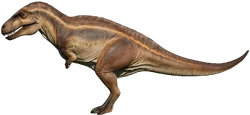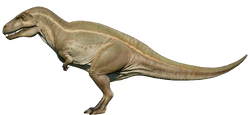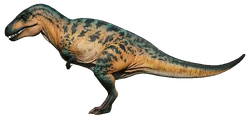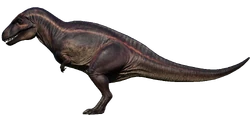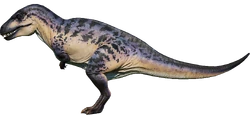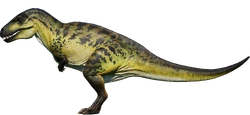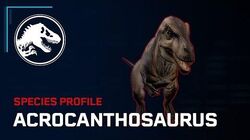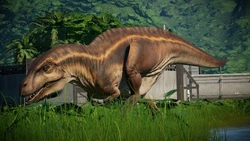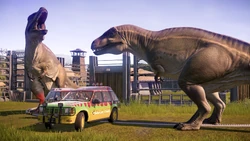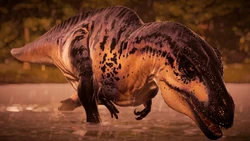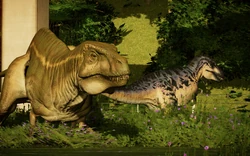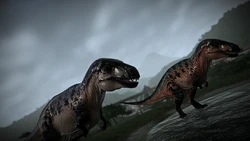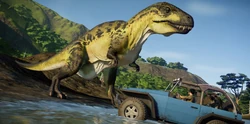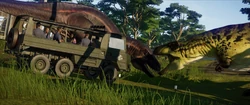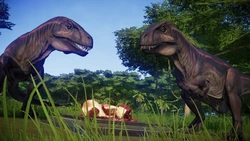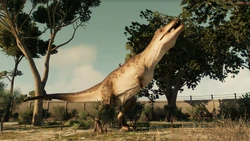| This bipedal predator is called Acrocanthosaurus, and it is a dinosaur that has what I like to refer to as "presence". When it's around, you know it. This animal should make for a killer exhibit, it being a killer and all, haha. |
Acrocanthosaurus is a genus of carcharodontosaurid dinosaur in the Jurassic World Evolution series. Best known for the high neural spines on its vertebrae, it originated from Early Cretaceous North America.
In Evolution, Acrocanthosaurus is included in the Carnivore Dinosaur Pack, and can be unlocked by progressing through the Entertainment Division on Isla Pena, where its fossils can subsequently be excavated in the Antlers and Twin Mountain formations in North America.
In Evolution 2, Acrocanthosaurus is unlocked by researching and successfully releasing one in the Northwest USA Challenge Mode map, and subsequently become available in Sandbox mode.
Characteristics

Database image
A powerful and fearsome North American apex predator that dates back to the Early Cretaceous period and preyed on sauropods, ornithopods, and ankylosaurs, Acrocanthosaurus is one of the largest theropod dinosaurs in the Evolution series, at around 14 meters in length and seven tons in weight. It has a relatively large and long skull, very small arms and a long, heavy tail counterbalancing its head and robust body. Its sharp teeth and powerful jaw make it a fearsome predator comparable to the much more well-known Tyrannosaurus. There are ridged crests above the eyes, similar to those of other carcharodontosaurid dinosaurs, such as Giganotosaurus and Carcharodontosaurus. In a similar fashion to Spinosaurus, the most prominent feature of Acrocanthosaurus (and what gives it the name "Hgh-Spined Lizard") are its row of large, elongated spines, located on the vertebrae along the length of its neck and back. However, these spines differ from Spinosaurus in that they likely supported a ridge of muscle, rather than a sail. The spines could have been used to assert dominance and attract mates, or perhaps for body temperature regulation.
In Evolution, the base genome of Acrocanthosaurus is a coffee/brown colored body with a creme underbelly. A yellow-creme colored stripe starts from the eyes and goes right up to the tip of the tail. In Evolution 2, the base genome of Acrocanthosaurus is a beige colored body with a darker brown top and a cream white underside.
Gameplay
Evolution
| Dig site | Quality | Quantity |
|---|---|---|
| Antlers Formation | ★☆☆☆ ★★☆☆ ★★★☆ ★★★★ |
1 3 6 4 |
| Twin Mountains Formation | ★☆☆☆ ★★☆☆ ★★★☆ ★★★★ |
1 3 6 4 |
Behaviour
Acrocanthosaurus behaves very similarly to other large carnivores. It requires a large amount of grassland and some forest in their enclosures in order to be content. Due to its high comfort threshold, Acrocanthosaurus can become easily agitated if its requirements are not met. In comparison to carnivores like Tyrannosaurus and the Indominus rex, Acrocanthosaurus is more tolerant of its own kind, and can happily coexist with another member of its species, or live in solitude. The species also tolerates up to fifteen other dinosaurs in its enclosure.
When placed next to other larger carnivores and armored herbivores, Acrocanthosaurus will engage in death duels. Unlike other large carnivores who often bite their opponents during the attack, Acrocanthosaurus will headbutt their foe before biting down on them. It will hunt defenseless small herbivores and hadrosaurs, but It can cohabit with small carnivores such as Velociraptor, as the latter will avoid the large carnivore before combat.
Skins
Evolution 2
Cosmetics
Skins
Patterns
Paleontology
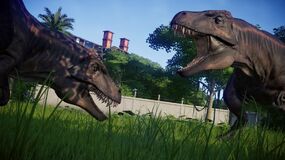
Two Acrocanthosaurus fighting.
While the first Acrocanthosaurus specimens to be discovered consisted of material from the Antlers Formation in Oklahoma, excavated in the early 1940s, Acrocanthosaurus itself was officially discovered in 1950 by J. Willis Stovall and Wann Langston Junior in Atoka County, Oklahoma, when the two paleontologists dug up skeleton fragments including part of a skull. In the following decades, there was little consensus on how to classify Acrocanthosaurus, and at various times it was believed to be a species of Allosaurus, Spinosaurus and Megalosaurus - but it is now considered part of the Carcharodontosaurus family. In the 1990s, Cephis Hall and Sid Love discovered a much more complete specimen which revealed information on the forelimbs, feet, and skull. Hall and Love's discovery was unusual in that it was a major dinosaur find, excavated by amateurs, independent from any academic or commercial sponsorship. Initially digging with permission, Hall and Love were taken to court once the company who owned the land found out how valuable the specimen was.
Like some carnivores, such as Allosaurus and Carcharodontosaurus, the skull of Acrocanthosaurus was long, low, and narrow. Its skull alone was nearly 1.3 m (4.3 ft) in length. The dinosaur itself measured 38 feet long weighed just over six tons, making it one of the largest predatory dinosaurs ever discovered. Armed with curved, serrated teeth, Acrocanthosaurus teeth were wider than those of Carcharodontosaurus and did not have the wrinkled texture that characterized the carcharodontosaurids.
Perhaps the most notable feature of Acrocanthosaurus, hence its name, was its row of tall neural spines running along the length of its neck, back, hips and upper tail, which could be more than 2.5 times the height of the vertebrae from which they extended and supported a ridge of muscle over the animal's overall upper body. Most other dinosaurs also had high spines on the back, sometimes much higher than those of Acrocanthosaurus. For instance, the unrelated Spinosaurus had spines nearly 2 m (6.6 ft) tall, about 11 times taller than the bodies of its vertebrae. The lower spines of Acrocanthosaurus had attachments for powerful muscles like those of modern bison, probably forming a tall, thick ridge down its back. While the exact function of the spines remains unknown, they may have been involved in communication, fat storage, muscle or temperature control as well as potentially to attract mates. All of its cervical (neck) and dorsal (back) vertebrae had prominent depressions (pleurocoels) on the sides, while the caudal (tail) vertebrae bore smaller ones. This is more similar to carcharodontosaurids than to Allosaurus.
Paleoecology
The apex predator of its time and likely to have inhabited multiple types of environment in its life, Acrocanthosaurus lived during the Early Cretaceous period, approximately 125-100 million years ago, in the Twin Mountains and Antlers Formations in the Southern states of the USA, most notably Texas, Oklahoma and Wyoming. At the time, these regions were coastal areas and large floodplains that drained into a shallow inland sea. The Acrocanthosaurus coexisted alongside numerous types of dinosaurs in its environment, including the smaller theropod Deinonychus, the ornithopods Iguanodon and Tenontosaurus, the spiky nodosaurid Sauropelta, as well as sauropods such as the titanic Sauroposeidon.
Gallery
External links
- Acrocanthosaurus on Wikipedia

